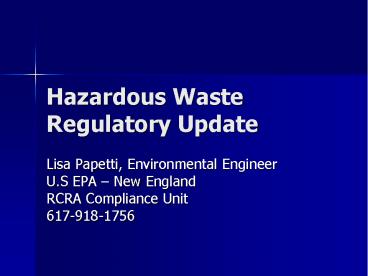Hazardous Waste Regulatory Update - PowerPoint PPT Presentation
Title:
Hazardous Waste Regulatory Update
Description:
Hazardous Waste Regulatory Update Lisa Papetti, Environmental Engineer U.S EPA New England RCRA Compliance Unit 617-918-1756 Things to think about Most small to ... – PowerPoint PPT presentation
Number of Views:180
Avg rating:3.0/5.0
Title: Hazardous Waste Regulatory Update
1
Hazardous Waste Regulatory Update
- Lisa Papetti, Environmental Engineer
- U.S EPA New England
- RCRA Compliance Unit
- 617-918-1756
2
Things to think about
- Most small to mid-sized hospitals should be
- operating as at least Small Quantity
Generators. However, the proper category can only
be confirmed through a full chemical and waste
inventory from cradle - to grave.
- Waste identification is critical for all areas
of the hospital -- train technicians in waste
determination and satellite storage.
3
Things to think about
- Greater than 1 kg or 2.2 lbs. of acutely
hazardous waste makes you a Large Quantity
Generator!! - P-listed wastes acutely toxic
4
Things to think about
- Use the Universal Waste Rule, where
- applicable.
- Check web pages and ask questions of
- regulatory agencies, trade groups, and
- professional societies.
- Always anticipate inspections, perform
- self-audits, and keep records.
5
Most Common RCRA Violation in Healthcare
- Hazardous waste determinations
- Improper disposal, including chemotherapy waste
- Improper management of expired pharmaceuticals
- Open containers
- Unmarked/unlabeled containers
- Satellite accumulation
- Hazardous waste training
- Contingency plan
- Improper consolidation of waste from nearby
facilities - Note Dont forget contractors and consultants
6
Locations Where Wastes Can Be Found
- Laboratories Operating rooms
- Nursing units Haz. waste areas
- Construction Satellite acc. areas
- Laundry Dental clinics
- Maintenance X-rays units
- Pharmacy Morgue
7
Typical Hospital Hazardous Waste
- Mercury and mercury-containing items
- Includes whole items and spill residue
- Photographic/X-Ray fixer solutions Silver
recovered from fixer, if not recycled
8
Typical Hospital Hazardous Waste
- X-Ray Film containing silver or other metals
- Ethanol and formaldehyde/ethanol solutions
- Spent, off-spec, or excess laboratory chemicals
(solvents, acids, bases, etc.) - Chemotherapy drugs
9
Typical Hospital Hazardous Waste
- Waste, excess, and off-spec paints and cleaning
products - Fluorescent light bulbs, if not managed as
Universal Wastes - Other types include
high-intensity discharge (HID), neon, mercury
vapor, high pressure sodium, and metal halide
lamps - Batteries, if not managed as Universal Wastes
10
Typical Hospital Hazardous Waste
- Computers/monitors, circuit boards, and other
lead-bearing electronics - Lead aprons and shielding
- Includes all cathode ray tube (CRT) screens
- Compressed gases (generally, any that are
- ignitable)
- Waste pesticides, fungicides, etc.
11
Specific Hospital HazardousWastes
- Cerrobend
- X-ray shielding putty used to protect patients
from damage to adjacent healthy tissue during
irradiation of tumors and other confined areas - Contains Lead and Cadmium
- Discarded material and shavings can be
characteristic toxic HW when disposed
12
Specific Hospital HazardousWastes
- Chemotherapy Drugs
- Several chemotherapy drugs (antineoplastics)
are listed in 40 CFR 261.33(f) (U-listed HW) - Listing includes discarded commercial
chemical products, off-specification
species,container residues, and spill residues
13
Specific Hospital HazardousWastes
- IV BAGS AND ASSOCIATED EQUIPMENT
- Empty bags and equipment that are not acutely
hazardous may be disposed as empty containers - Bags and equipment with regulated material
remaining must be managed as hazardous waste
14
Specific Hospital HazardousWastes
- Some Examples
- chlorambucil (U035)
- cyclophosphamide (U058)
- daunomycin (U059)
- melphalan (U150)
- mitomycin C (U010)
- streptozotocin (U206)
- uracil mustard (U237)
- - arsenic trioxide (P012!!!)
15
Specific Hospital HazardousWastes
- Mercury Containing Devices Products In Patient
Rooms - Temperature Measurement
- Blood Pressure
- Nursing Incubators
- Room Temperature Controllers
- Batteries
16
Specific Hospital HazardousWastes
- Mercury Containing Devices Products In Storage
Maintenance Rooms - Antifouling agents
- Cleaning Chemicals
- Degreasers
17
Specific Hospital HazardousWastes
- Mercury Containing Devices Products In Storage
Maintenance Rooms - Preservatives
- Solvents
- Outdated mercury-containing equipment
- Paints
18
Specific Hospital HazardousWastes
- Mercury Containing Devices Products In
Treatment Surgery Rooms - Merthiolate
- Mercury Nitrate
- Mercury Iodide
- Mercurochrome
- Thimerosal
19
Specific Hospital HazardousWastes
- Mercury Containing Devices Products in
Treatment Surgery Rooms - Esophageal Dilators
- Cantor Tubes
- Miller Abbot Tubes
- Feeding Tubes
- Dental Amalgam
20
Specific Hospital HazardousWastes
- Sodium Azide P105
- Also found in Enterococcus agars
- Listed in 40 CFR 261.33(e) (P-listed HW)
- Listing includes discarded commercial chemical
products, off-specification species, container
residues, and spill residues
21
Specific Hospital HazardousWastes
- Picric Acid
- 2,4,6-trinitrophenol, picronitric acid, melinite
- Sometimes used in histology labs
- A component of Bouins Solution tissue
- preservative
- Dry picric acid is explosive and disposal is very
costly and disruptive
22
EPA New Englands Most Recent Enforcement Action
- Veterans Administration-New England
Healthcare System - White River Junction, VT
- Total Penalty 372,254
23
EPA New Englands Most Recent Enforcement Action
- Violations
- Failure to conduct waste determination
- Failure to have fire suppression equipment
- Failure to label
- Failure to close containers
- Failure to date containers
- Unauthorized treatment and disposal
- Failure to minimize potential for release
- Failure to conduct hazardous waste training
- Universal Waste dating
- Failure to separate incompatibles
24
EPA New England Compliance Assistance
- Janet Bowen
- Bowen.janet_at_epa.gov
- 617-918-1795
- www.epa.gov/region1/healthcare

